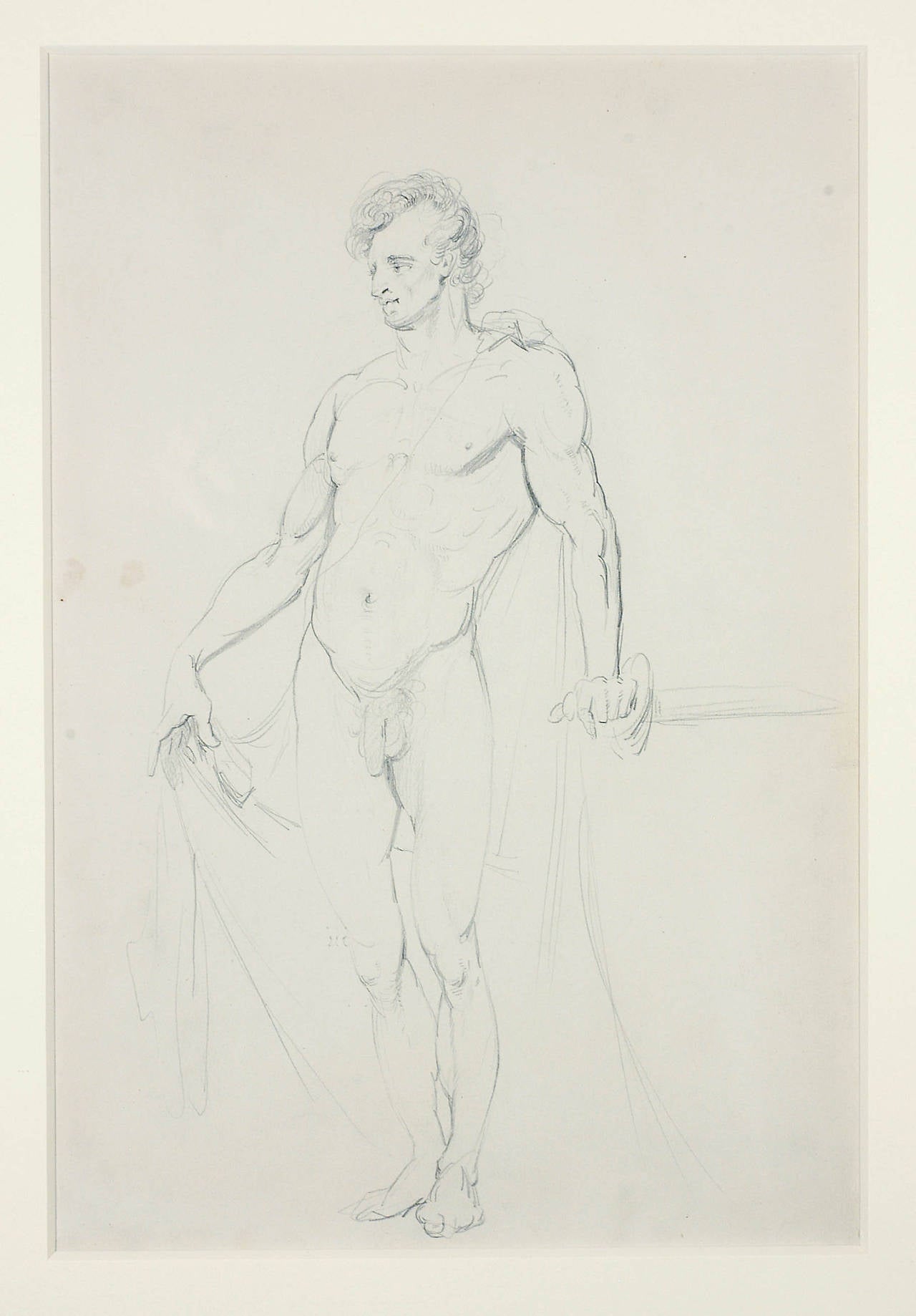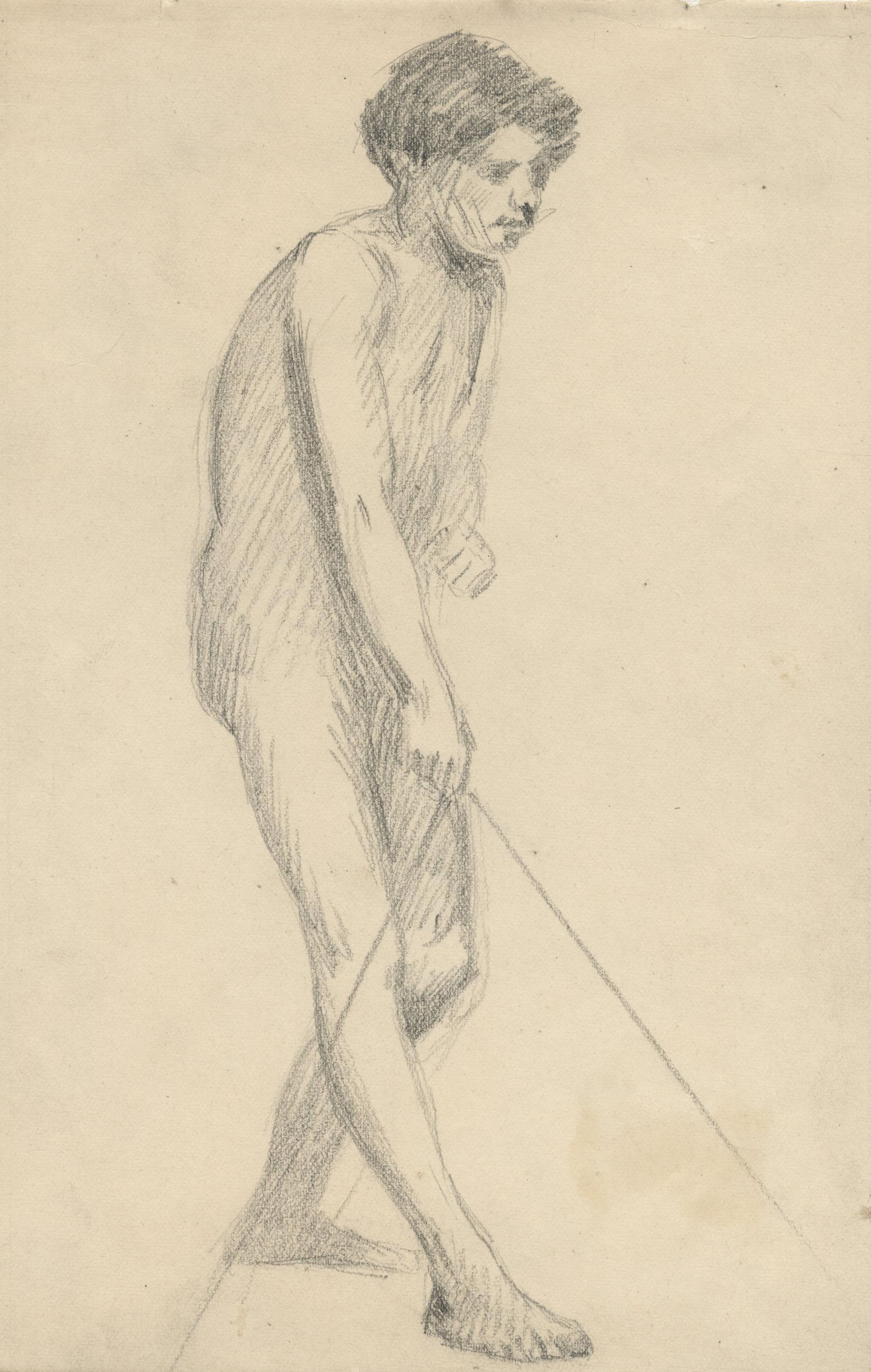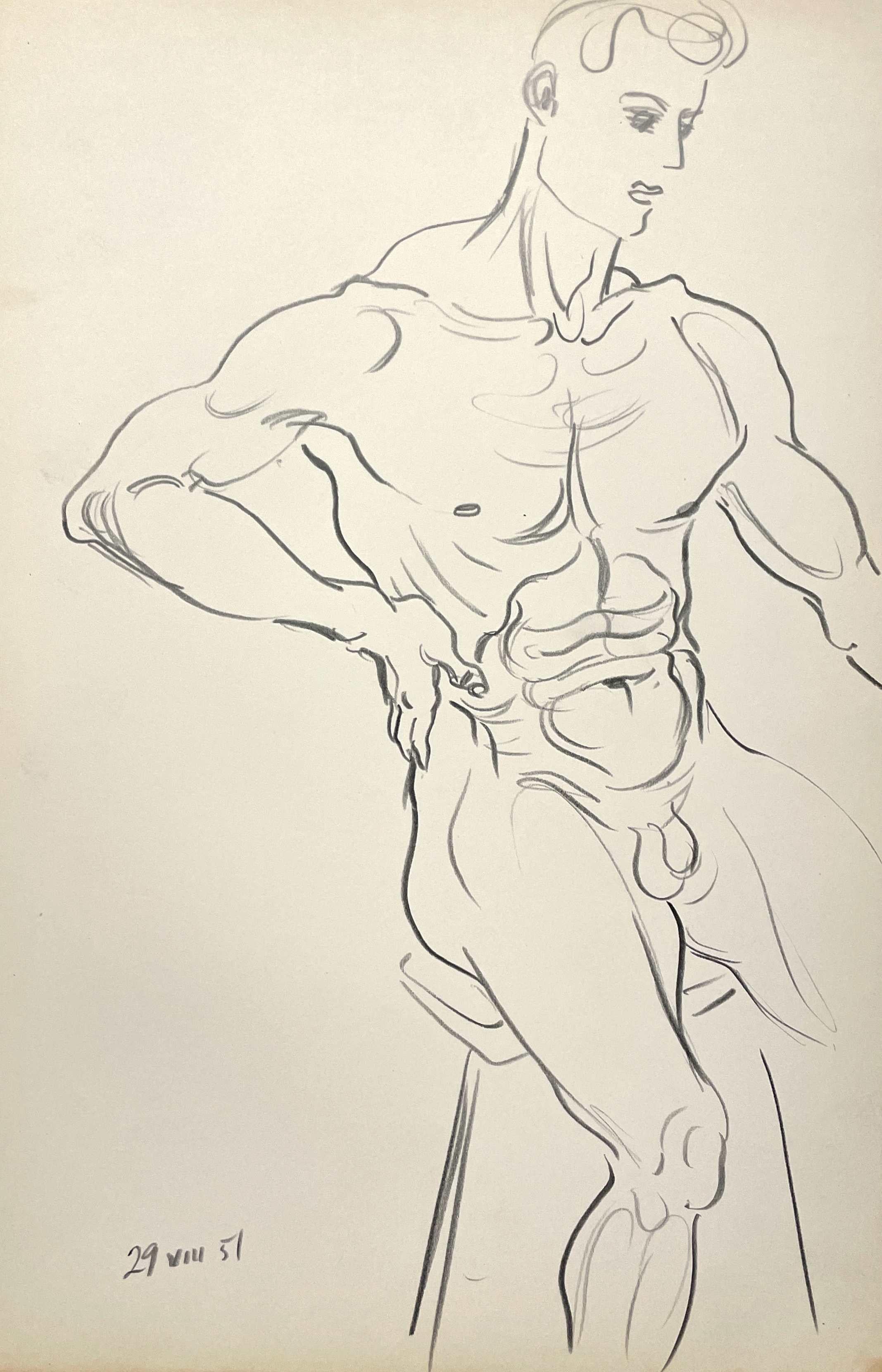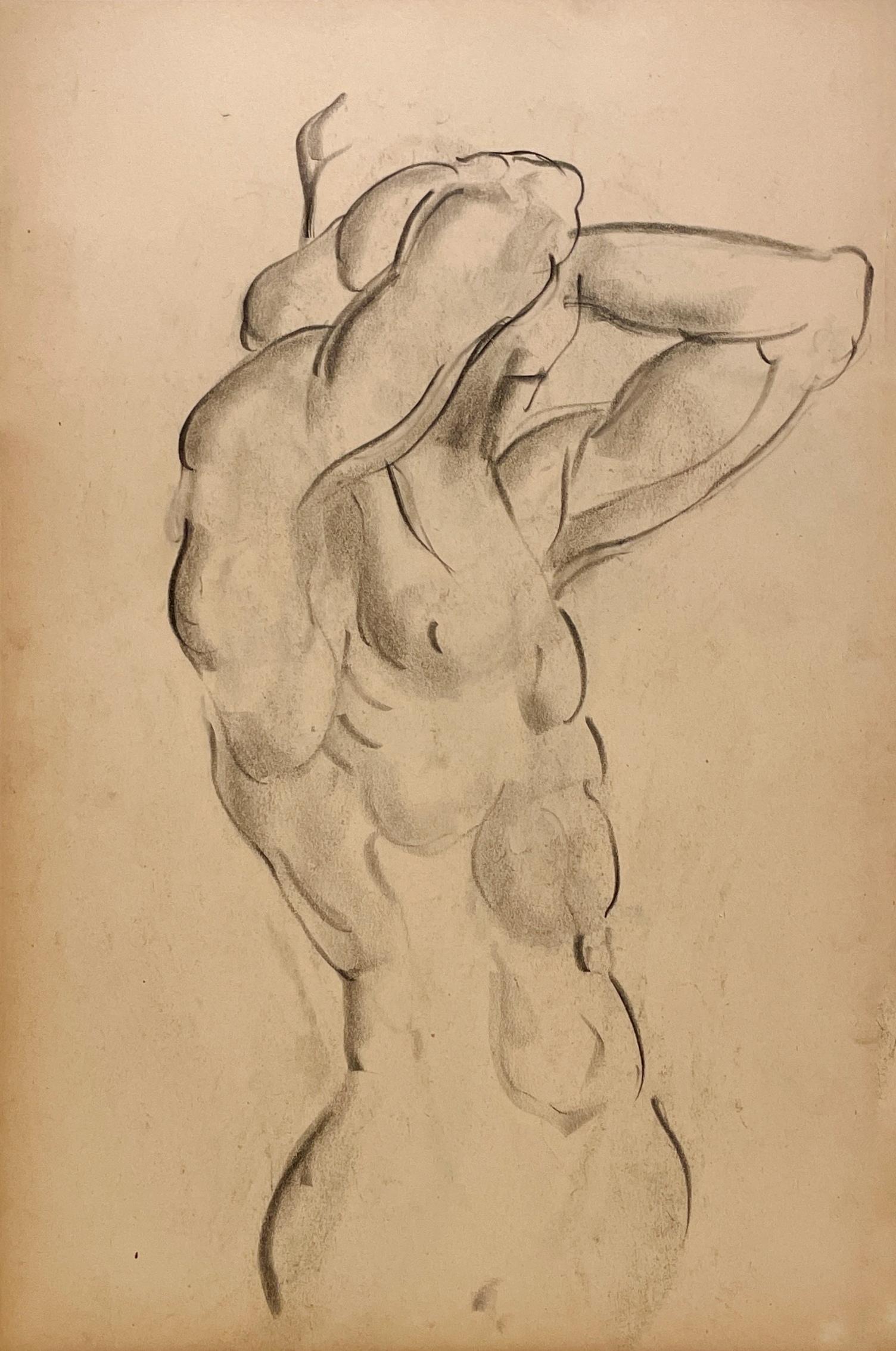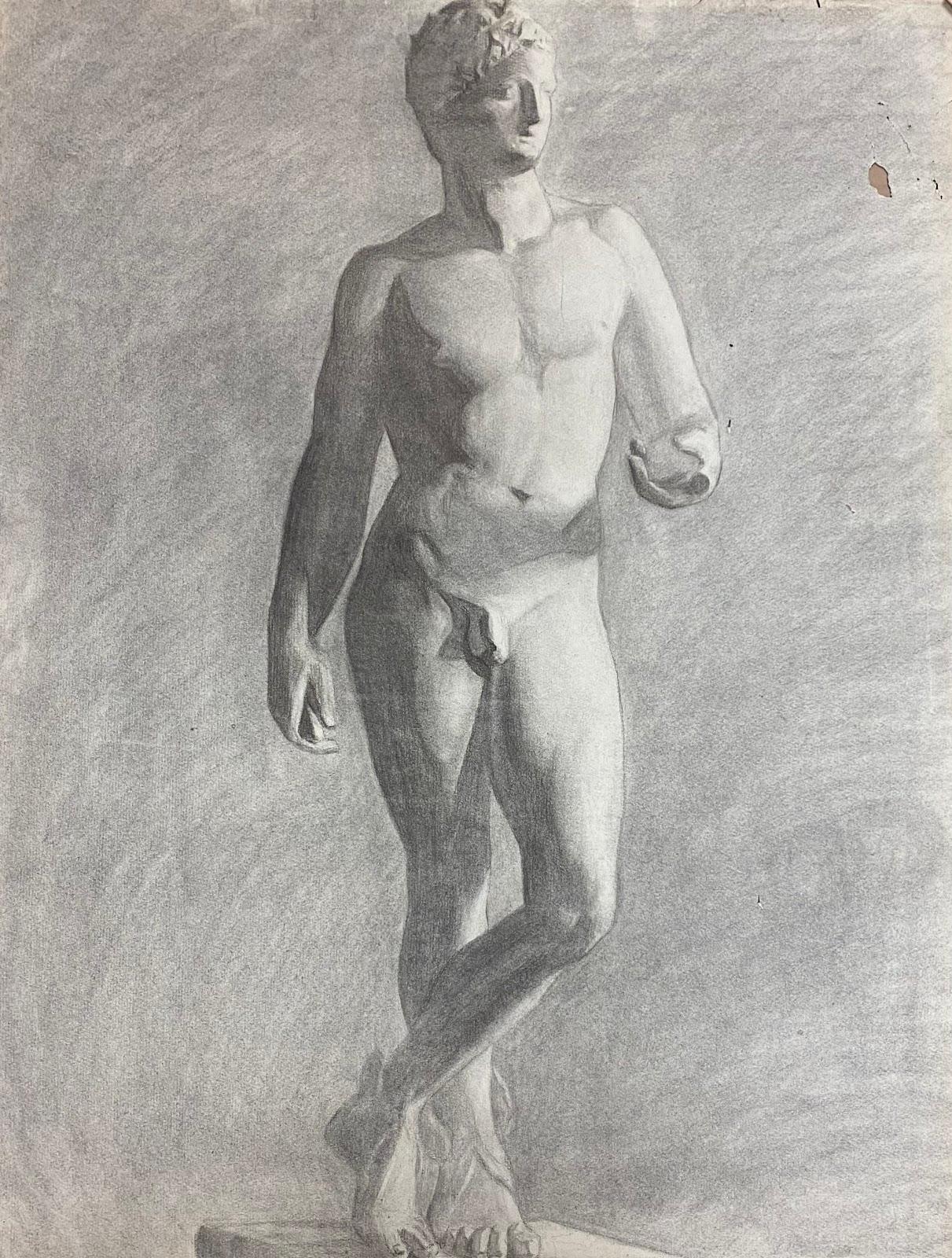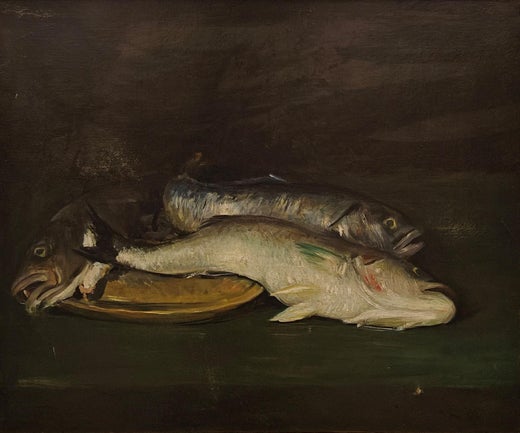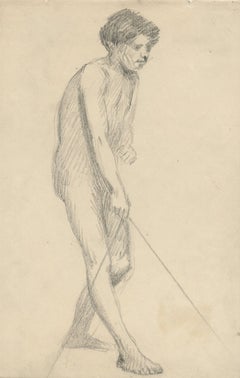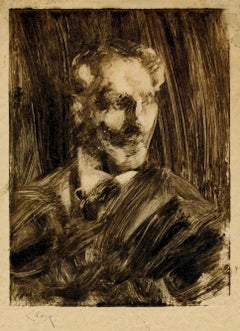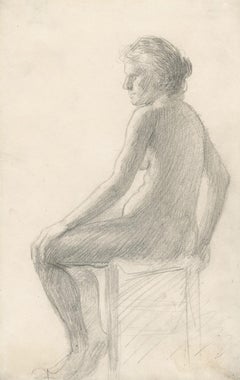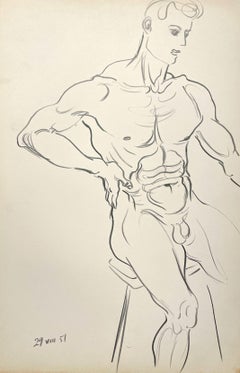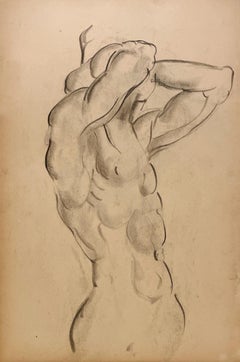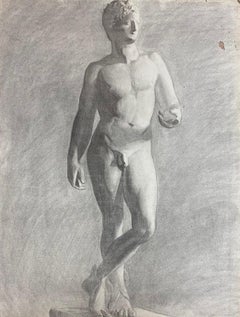Items Similar to Standing Male Nude (recto) Study of the Head of the Standing Male Nude (verso)
Want more images or videos?
Request additional images or videos from the seller
1 of 15
William Merritt ChaseStanding Male Nude (recto) Study of the Head of the Standing Male Nude (verso)c. 1875
c. 1875
$15,000
£11,468.30
€13,209.16
CA$21,019.60
A$23,466.41
CHF 12,296.04
MX$287,251.84
NOK 156,159.88
SEK 147,238.94
DKK 98,581.34
Shipping
Retrieving quote...The 1stDibs Promise:
Authenticity Guarantee,
Money-Back Guarantee,
24-Hour Cancellation
About the Item
Standing Male Nude (recto)
Study of the Head of the Standing Male Nude (verso)
Unsigned
Provenance:
Estate of the artist
Helen Chase Storm (the artist's daughter)
Jackson Chase Storm (the artist's grandson)
Baker-Pisano Collection (the author of the William Merritt Chase Catalog Raisonne Project)
References And Exhibitions:
Pisano D8, reproduced p. 183
Rare. Chase did relatively few drawings, probably no more than 150 in total, according to the catalogue raisonne.
William Merritt Chase (1840-2016)
Born in Nineveh, Indiana Died New York, New York
In 1883 Chase was involved in the organization of an exhibition to help raise funds for a pedestal for the Statute of Liberty. The exhibition featured loans of three works by Manet and urban scenes by the Italian Impressionist Giuseppe de Nittis. Both artists influenced Chase's Impressionistic style that gave rise to a series of New York park scenes. It is also thought that he was influenced by John Singer Sargent's In the Luxembourg Gardens (1879) which was exhibited in New York at this time. Indeed, Chase had met Sargent in Europe in 1881, the two men becoming lifelong friends with Sargent painting Chase's portrait in 1902.
On another European trip in 1885, Chase met James McNeill Whistler in London. While Whistler had a reputation for being difficult, the two artists got along famously and agreed to paint one another's portrait. Eventually, however, Whistler's moods began to grate with Chase who wrote home stating "I really begin to feel that I never will get away from here". For his part, Whistler criticized Chase's finished portrait and, according to Hirshler, "complained about Chase for the rest of his life". While no record exists of Whistler's portrait of Chase; Chase's portrait of Whistler remains a well-known piece in his oeuvre.
In 1887 Chase married Alice Gerson, the daughter of the manager of a lithography company. Though some fifteen years his junior (Chase was 37), he had known Alice for some time through her family's devotion to the arts. The pair, who would enjoy a happy marriage with Alice in full support of her husband's career, settled initially in Brooklyn where their first child was born. The couple would parent six daughters and two sons and it was only his family that could rival his devotion to his art. Indeed, Chase often combined his two loves by painting several portraits of his wife and children in Brooklyn parks before the couple relocated to Manhattan.
Later Period
Between 1891 and 1902, Chase and his family spent their summers at a purpose-built home and studio in Shinnecock Hills, a close suburb of the upmarket town of Southampton on the south shore of Long Island (roughly 100 miles east of New York). Chase set up, and taught two days a week, at the nearby Shinnecock Hills Summer School of Art which benefitted from the financial backing of local art collectors. It was at Shinnecock that Chase, taken in by the region's striking natural surroundings, painted several Impressionistic landscapes. As Bettis put it, "There, among the dunes, in the bright sunlight and sea air his painterly impulse was given free sway, and he produced some of his freest and loveliest work". His passion for the area was so felt he even gave his daughter Hazel the middle name of Neamaug, in honor of the rich Native American history of Shinnecock. Chase was equally focused on the students that came to the School and who he encouraged to paint in the modern plein air style favored by the French Impressionists.
Although Chase was making a name for himself as an Impressionist, he never abandoned his commitment to the sombre tones and academic tropes he had learned in Munich, though these he reserved for his portraits, and for his series of striking still lifes featuring dead fish. Chase was in fact a successful society portraitist - he painted fashionable women for a fee of $2,000 - and would paint his students as "samples" which he then donated to leading art institutions (such as Lady in Black (1888) which he donated to the Metropolitan Museum in 1891).
In 1896, facing financial difficulties, Chase flirted with the idea of giving up his teaching in New York and traveled with his family to Madrid where he developed a passion for bullfighting. Chase returned however to Shinnecock in June to teach his yearly summer art class, and in the fall of that year, established his own art school in Manhattan: the Chase School which was modelled on the Académie Julian in Paris. Chase lacked business savvy, however, and the Chase School lasted only two years before it was placed under new management. It continued as the New York School of Art (changed to Parsons School of Design starting 1941) with Chase as head the School for eleven more years. Chase also taught during this period at the Pennsylvania Academy of Fine Arts.
In 1902, following the premature death of his friend John Twachtman, Chase was invited to join the Ten American Painters group (who included amongst its members, Frank Weston Benson, Thomas Wilmer Dewing, Robert Reid and Julien Alden Weir) with whom he continued to exhibit for the remainder of his career. Like Chase, the other group members were committed to the philosophy of Eclecticism. As the art historian Isabel L. Taube described it, Eclecticism amounted to more than just a "jumble of sources" and depended rather on "clear intention and reason instead of chance and intuition". She adds that by the late nineteenth century "discussions of eclecticism in popular magazines and trade publications emphasized the difficult and serious study required to achieve a harmony of diverse elements in architecture as well as the fine and decorative arts".
Though he painted and exhibited until his death in 1916, in this later years Chase devoted more and more time to teaching, dividing his time between Europe and America. Between 1902 and 1913 he spent his summers travelling to Europe where he taught classes in Belgium, England, Italy, Holland and Spain. His last European class was held in Venice in the summer of 1913. Chase had also taken great pride in the studio set up he established at Fourth Avenue in 1908. Here he taught private classes while continuing to work enthusiastically on his own paintings. He maintained his association with the Art Students League of New York until 1912 and, in 1914, he experienced a new teaching environment by conducting summer classes on the West Coast in Carmel, California. During the winter of 1916, Chase began to feel unwell. Though he continued to paint, he grew increasingly ill from what was diagnosed as cirrhosis of the liver. Forced to cut short a visit to Atlantic City, Chase returned to New York where he died two days later aged just sixty-six.
The Legacy of William Merritt Chase
Chase had a profound impact on shaping the development of modern art in the United States. As curator Erica Hirshler explains, "Chase developed an American version of Impressionism to depict modern subjects" and started incorporating other modern artmaking techniques in the way he "often employed daringly abstract compositions, devising interlocking patterns of vertical and horizontal lines or dramatic diagonal sweeps that provided a firm geometric foundation for his loose strokes of color". She adds that he "also experimented with different media and was an innovator in the revival of painting in pastel". Indeed, according to the Phillips Collection website, as "co-founder of the progressive Society of American Painters in Pastel, Chase was a leader in the late 19th-century revival of pastel painting and one of its most innovative practitioners".
Chase also created an impressively important legacy as an art teacher. While the notion of plein air painting had been embraced by the French Impressionists, Chase led the way in importing that approach to America; both through the example of his own works but also by encouraging his students to engage in the practice as well. Unlike some instructors who required students to mimic their own methods, Chase chose simply to encourage his students to explore their own artistic paths. As Hirshler explains, "perhaps Chase's success as a teacher is marked by the fact that only some of his students followed his stylistic example; others - among them Lydia Field Emmet, Rockwell Kent, Marsden Hartley, Edward Hopper, Charles Sheeler, and Georgia O'Keeffe - used what they learned in his classes as a springboard for their own artistic innovations". He was also considered a trailblazer in his appreciation of women artists. As author Christina Michelon explains, "Chase's modern thinking extended to [...] his mentoring of female students.
Courtesy of The Art Story
- Creator:William Merritt Chase (1849-1916, American)
- Creation Year:c. 1875
- Dimensions:Height: 15 in (38.1 cm)Width: 10 in (25.4 cm)
- Medium:
- Movement & Style:
- Period:
- Condition:Extremely RARE.
- Gallery Location:Fairlawn, OH
- Reference Number:Seller: FA47251stDibs: LU14015238442
William Merritt Chase
William Merritt Chase rejected his father’s shoe business in favor of studying art professionally, training with Barton S. Hayes in Indianapolis and going abroad to the Royal Academy in Munich. His brushwork and use of light was similar to the French Impressionists, and his style of visual modelling was particularly influenced by Eduoard Manet. After he finished his studies Chase travelled to New York City and began teaching as part of the Art Students League, quickly becoming a renowned teacher. He incorporated Impressionist techniques along with his more traditional European education to create unique images imbued with the valued urbanization and expansion of New York City. Later in his life, Chase established the Chase School, which eventually was renamed the Parsons School of Design.
About the Seller
5.0
Recognized Seller
These prestigious sellers are industry leaders and represent the highest echelon for item quality and design.
Gold Seller
Premium sellers maintaining a 4.3+ rating and 24-hour response times
Established in 1978
1stDibs seller since 2013
799 sales on 1stDibs
Typical response time: <1 hour
Associations
International Fine Print Dealers Association
- ShippingRetrieving quote...Shipping from: Fairlawn, OH
- Return Policy
Authenticity Guarantee
In the unlikely event there’s an issue with an item’s authenticity, contact us within 1 year for a full refund. DetailsMoney-Back Guarantee
If your item is not as described, is damaged in transit, or does not arrive, contact us within 7 days for a full refund. Details24-Hour Cancellation
You have a 24-hour grace period in which to reconsider your purchase, with no questions asked.Vetted Professional Sellers
Our world-class sellers must adhere to strict standards for service and quality, maintaining the integrity of our listings.Price-Match Guarantee
If you find that a seller listed the same item for a lower price elsewhere, we’ll match it.Trusted Global Delivery
Our best-in-class carrier network provides specialized shipping options worldwide, including custom delivery.More From This Seller
View AllStanding Male Nude (recto) Study of the Head of the Standing Male Nude (verso)
By William Merritt Chase
Located in Fairlawn, OH
Standing Male Nude (recto)
Study of the Head of the Standing Male Nude (verso)
Unsigned
Provenance:
Estate of the artist
Helen Chase Storm (the arti...
Category
1870s American Impressionist Nude Drawings and Watercolors
Materials
Graphite
Standing Male Nude
By Frank Duveneck
Located in Fairlawn, OH
Standing Male Nude
Graphite on wove paper, c. 1890's
Unsigned
Sheet size: 9 5/16 x 6 inches
Provenance:
Rookwood Pottery Factory Collection, Cincinnati
Ira Spanierman, New York (labe...
Category
1890s Nude Drawings and Watercolors
Materials
Graphite
Portrait of a Man Facing Left
By William Merritt Chase
Located in Fairlawn, OH
Portrait of a Man Facing Left
Monotype printed in brown ink, c. 1880-1914
Signed in ink lower left: Chase (see photo)
Provenance:
Helen Chase Storm (the artist's daughter)
Jackson Chase Storm (her son)
Chapellier Galleries (as agent)
James Bergquist, Boston
References And Exhibitions:
Exhibited at the Museum of Fine Arts, Boston and the Clark Art Institute, Williamstown, MA. (See MFA paperwork in photos)
Reference:
Ronald G. Pisano, Completed by D. Frederick Baker and Carolyn K. Lane, William Merritt Chase: Still Lifes, Interiors, Figures, Copies of Old Masters, and Drawings, Catalogue Raisonne, Vol. IV (New Haven and London: Yale University Press, 2010), Vol. 1, M. 8. (See photos of entry)
William Merritt Chase (1840-2016)
Born in Nineveh, Indiana Died New York, New York
In 1883 Chase was involved in the organization of an exhibition to help raise funds for a pedestal for the Statute of Liberty. The exhibition featured loans of three works by Manet and urban scenes by the Italian Impressionist Giuseppe de Nittis. Both artists influenced Chase's Impressionistic style that gave rise to a series of New York park scenes. It is also thought that he was influenced by John Singer Sargent's In the Luxembourg Gardens (1879) which was exhibited in New York at this time. Indeed, Chase had met Sargent in Europe in 1881, the two men becoming lifelong friends with Sargent painting Chase's portrait in 1902.
On another European trip in 1885, Chase met James McNeill Whistler in London. While Whistler had a reputation for being difficult, the two artists got along famously and agreed to paint one another's portrait. Eventually, however, Whistler's moods began to grate with Chase who wrote home stating "I really begin to feel that I never will get away from here". For his part, Whistler criticized Chase's finished portrait and, according to Hirshler, "complained about Chase for the rest of his life". While no record exists of Whistler's portrait of Chase; Chase's portrait of Whistler remains a well-known piece in his oeuvre.
In 1887 Chase married Alice Gerson, the daughter of the manager of a lithography company. Though some fifteen years his junior (Chase was 37), he had known Alice for some time through her family's devotion to the arts. The pair, who would enjoy a happy marriage with Alice in full support of her husband's career, settled initially in Brooklyn...
Category
1890s Impressionist Portrait Prints
Materials
Monoprint
Side View Seated Female Nude
By Frank Duveneck
Located in Fairlawn, OH
Side View Seated Female Nude
Graphite on paper, c. 1890's
Unsigned
Provenance:
Rookwood Pottery Factory Collection, Cincinnati
Spanierman Gallery, New York (label)
Drawings from the...
Category
1890s American Impressionist Nude Drawings and Watercolors
Materials
Graphite
Side View Seated Female Nude
By Frank Duveneck
Located in Fairlawn, OH
Side View Seated Female Nude
Graphite on paper, c. 1890's
Unsigned
Provenance:
Rookwood Pottery Factory Collection, Cincinnati
Spanierman Gallery, New York (label)
Drawings from the...
Category
1890s American Impressionist Nude Drawings and Watercolors
Materials
Graphite
Study of an Indian Model
By Arthur B. Davies
Located in Fairlawn, OH
Study of an Indian Model
Unsigned
Pastel and chalk on blue paper, mounted to support
Provenance:
Estate of the artist (per Graham and Sons, agent for the estate)
James Graham & Sons,...
Category
1920s Ashcan School Nude Drawings and Watercolors
Materials
Chalk, Pastel
You May Also Like
Vintage Male Erotica 1951 Graphite on Paper Figure Study by Artist Harold Haydon
By Harold Haydon
Located in Chicago, IL
A black and white figure study of a standing nude male, from 1951, by artist Harold Haydon. Artwork size:
19" x 12 1/2". Archivally matted to 24" x 20". Provenance: Estate of t...
Category
1950s American Modern Nude Drawings and Watercolors
Materials
Graphite, Paper
Pre-Second Republic Academic Study Of A Male Nude Framed 1840s French Drawing
Located in Sutton Poyntz, Dorset
Henry Arthur Roberts.
French ( b.1819 - d.1900 ).
Academic Life Study Of A Standing Male Nude.
Pencil & Charcoal On Paper.
Paper size 23.8 inches x 13.6 inches ( 60.5cm x 34.5cm ).
Frame size 28.3 inches x 18.7 inches ( 72cm x 47.5cm ).
Available for sale; this academic life drawing of a male nude is by the French artist Henry Arthur Roberts and dates from the early 1840s.
The drawing is presented and supplied in a modest hand painted glazed wooden frame dating from the mid-20th century (which is shown in these photographs).
This antique drawing is in good condition, commensurate with its age. It is in an untouched condition having never been restored. The paper has handling marks, some light surface dirt, the odd foxing mark and general age toning. The overall patina adds to the aesthetic and is supplied ready to hang and display.
The drawing is not signed but came from a portfolio of drawings by Henry Arthur Roberts.
Henry Arthur Roberts was a recognised French artist, notable for his portraits and paintings of religious subjects. Born in Paris in 1819, he was the son of British watercolour artist James Roberts, himself active in Paris from 1819 -1846. Henry became a student of his father.
Henry Roberts’s talent as a young man was such that he was accepted as a student of Michel Martin Drölling and worked extensively with him. Drölling, the highly acclaimed neoclassic artist (1786-1851) was noted for his theatrical paintings of history and grand portraits. He produced many notable works, including a ceiling work for the Louvre, and works in the Palace of Versailles. Roberts would have studied with Drölling at an early stage in his career, as Drölling died when Roberts was 32. Learning with such a master would have had a huge impact on Roberts in terms of his academic skills and his own emerging style.
Roberts exhibited at the Salon de Paris from 1839, when he was only 20 years old, right through to 1867. His work in the Universal Exhibition of 1855 won him a Third Class Medal. He became Vice-President of the Association of Artists in Paris and in July 1898 he was elevated to the rank of Knight of the Legion of Honour with a foreign title. This was the highest state honour available to him, in recognition of his status as an artist.
Henry Roberts died in 1900, but his legacy lives on, with works in many famous public collections, including the Musée Carnavalet, the Musée du Louvre, the Musée d’Orsay, Musée des Beaux-Arts, Orsay, and in Boston, USA.
© Big Sky Fine Art
This exceptional academic nude...
Category
1840s Academic Nude Drawings and Watercolors
Materials
Charcoal, Paper, Pencil
A Fine 1930s, Modern Academic Figure Study Drawing of a Standing Male Nude Model
By Harold Haydon
Located in Chicago, IL
A Fine 1930s, Modern Academic Figure Study Drawing of a Standing Male Nude Model by Notable Chicago Artist, Harold Haydon (Am. 1909-1994). An exceptionally well executed, early 1930...
Category
1930s American Modern Nude Drawings and Watercolors
Materials
Paper, Charcoal
1900s French Atelier Academic Drawing Portrait of Classical Male Nude Sculpture
Located in Cirencester, Gloucestershire
Life study drawing
original atelier drawing
by the French artist, Jeanne Nachat (1898-1984)
Nachat attended the prestigious Académie des Beaux-Arts in Pa...
Category
Early 20th Century Academic Nude Drawings and Watercolors
Materials
Charcoal, Pencil
Academic Study (Male Nude)
Located in London, GB
Charcoal on paper, signed by the artist (upper right), and RA visitor L. Alma Tadema, RA., and dated (lower left), 76cm x 57cm, (64cm x 88cm framed).
Olivier studied at the Royal Academy Schools from 1881, where this extraordinary display of drafting took place. Olivier exhibited extensively, including the Royal Academy starting in 1883, and the Paris Salon. He exhibited at the Fine Art Society in the 1880s and at the Grafton Galleries in 1908. An official war artist in the Great War, his work is included in the collection of the Imperial War Museum. It is also contained in many regional art galleries. Drawings of the nude, called academic studies...
Category
1880s Victorian Nude Drawings and Watercolors
Materials
Charcoal, Paper
English Graphite Portrait Sketch of Male Nude, in Profile
By Henry George Moon
Located in Cirencester, Gloucestershire
English Graphite Sketch of a Male Nude, in Profile
by Henry George Moon (British 1857-1905)
on pale blue/grey artists paper, unframed
measurements: sheet 18.5 x 12 inches
provenance...
Category
Late 19th Century Impressionist Nude Drawings and Watercolors
Materials
Graphite
More Ways To Browse
Architectural Drawing Study
Male Nude Painting
William Given
Black Male Nude
Male Nude Study
Study Of A Male Nude
Nude Native
Male Female Nude
Nude Male Model
Impressionist Female Nude
Nude Couple
Nude Couple Art
Dutch Nude
Nineteenth Century Drawings
French 19th Century Architectural Drawings
Nude Embracing Painting
Dior Two Piece Set
Antique Nude Male
